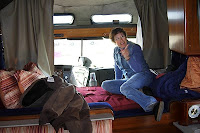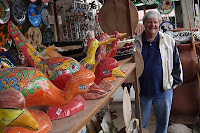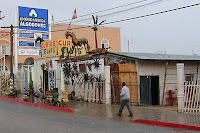Guerrero Negro is a small town of somewhere between 12,000 and 15,000 people, depending on who you ask. Some are employed in the normal service jobs -- gas stations, restaurants, grocery stores, and the like. The best job in town is in the world's largest salt mining operation, where the employees can shop in the company store (goods at half price), their kids go to the best school in the area, and they live in a housing development that has paved streets and a gate (most of the side streets here are dirt). Don't come here and expect to get a job there, though -- the jobs are inherited, so only the children of workers can get them.
The other industry here is tourism, and by that everyone means the Gray Whale (Ballena Gris). Just east of Guerrero Negro is a round cove officially called Scammons Cove, but everyone calls it Ojo de Liebre, or Eye of the Jackrabbit. It got its nickname for murky reasons that seem to involve someone thinking the surrounding area looked like a hare (it doesn't) or that the cove was shaped like a hare's eye (why a hare? Just how different is a hare's eye from, say a squirrel's or a coyote's or a bird's?).
 This cove is special, however, because each winter it fills with 1000 or so gray whales, who come here to calve and then nurse their babies until the end of March when they return to the Pacific Ocean. The females weight 35-45 tons and average 48 feet long (males are a bit smaller), but the babies only weigh a paltry 1 ton at birth and are 15 feet in length.
This cove is special, however, because each winter it fills with 1000 or so gray whales, who come here to calve and then nurse their babies until the end of March when they return to the Pacific Ocean. The females weight 35-45 tons and average 48 feet long (males are a bit smaller), but the babies only weigh a paltry 1 ton at birth and are 15 feet in length.
 Today we took a boat excursion into the lagoon. We eventually found ourselves in the middle of the whales, watching them surface, blow, and dive. At first the whales we saw were only in the distance and that alone was thrilling -- but as we moved through the cove, they started to come in closer and closer until they were about 50 feet away. We would see one, or maybe two cows at at time. Near the end of our trip, we had a couple whales who were curious enough about us to dive directly under our boat and come up next to it, babies at their sides. On man on our boat almost got to touch one of them -- just as he was reaching down, the whale "blew" and covered him in water! I was just forward of his seat, so I got a good look at the whale, and the whale got a good look at me -- I got to see this gigantic eye staring at me just before she submerged. Amazing.
Today we took a boat excursion into the lagoon. We eventually found ourselves in the middle of the whales, watching them surface, blow, and dive. At first the whales we saw were only in the distance and that alone was thrilling -- but as we moved through the cove, they started to come in closer and closer until they were about 50 feet away. We would see one, or maybe two cows at at time. Near the end of our trip, we had a couple whales who were curious enough about us to dive directly under our boat and come up next to it, babies at their sides. On man on our boat almost got to touch one of them -- just as he was reaching down, the whale "blew" and covered him in water! I was just forward of his seat, so I got a good look at the whale, and the whale got a good look at me -- I got to see this gigantic eye staring at me just before she submerged. Amazing.
 It was extremely difficult to get good pictures -- the whales behavior was unpredictable and the sea was very choppy so not only did I have to try to anticipate where the whale would be, but I had to try to snap the shutter when we were not rolling on the waves (good thing I had Dramamine!). But I'm posting a few that at least show how close we were to the whales.
It was extremely difficult to get good pictures -- the whales behavior was unpredictable and the sea was very choppy so not only did I have to try to anticipate where the whale would be, but I had to try to snap the shutter when we were not rolling on the waves (good thing I had Dramamine!). But I'm posting a few that at least show how close we were to the whales.
This was truly a special excursion that I will not soon forget.

















































